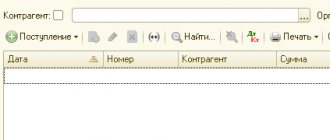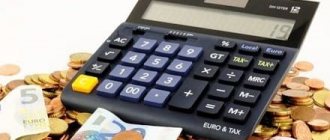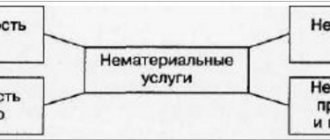Subordinate to the “Revenue” account (90.01).
Account type: Passive.
Account type:
- Quantitative
- Tax
Analytics for account “90.01.1”:
| Subconto | RPM only | Total accounting | Accounting in currency |
| Nomenclature groups | Yes | Yes | Yes |
| VAT rates | Yes | Yes | Yes |
| Nomenclature | Yes | Yes | Yes |
Why do we need count 90?
Account 90 “Sales” is needed to collect information on the sale of goods or services. Revenue and expenses from such operations are recorded here:
- sale of finished products or goods for resale;
- provision of various services: construction, installation, transport and so on;
- execution of work;
- rental of property;
- participation in the authorized capital of another company, and so on.
Count 90 is an active-passive count. Its debit records income, and its credit records expenses. The difference between a debit and a credit is the company's profit or loss.
Description of the account “Cost of sales for activities with the main tax system”
Subaccount 90.02.1 is used to summarize information about transactions at cost of sales. The account is used in enterprises with a basic taxation system. The account reflects the cost amounts for the main types of activities: own-produced products and semi-finished products, services (both industrial and other nature), construction and installation, geodetic, design survey and other works.
The basis for making entries in subaccount 90.02.1 is cost calculation. Analytical accounting of an account is organized by type of product (service, work).
What is the procedure for recognizing income
Income and expenses are not the same as receipts or debits of money from a current account. Revenue can be recognized even if the money has not yet arrived in the account. The procedure for recognizing income and expenses is fixed in PBU 9/99 and PBU 10/99, respectively.
Revenue recognition
The procedure for recognizing income from the main activity is established in PBU 9/99. Revenue can only be recognized if the following conditions are met:
- the organization has the right to receive income, for example, there is an agreement with the buyer;
- the amount of revenue is precisely determined;
- the operation is aimed at increasing economic benefits;
- ownership of the goods has passed from the organization to the buyer;
- the costs associated with the sale can be reliably determined.
Account 90 records only revenue from core activities. For example, if a company sells gingerbread cookies, then the income from the sale of sweets will be credited to account 90. But if the same company sold part of the flour and sugar, that is, raw materials, then the income will fall to the credit of account 91 “other income and expenses.”
Keep records of exports and imports in the Kontur.Accounting web service. Simple accounting, payroll and reporting in one service
Recognition of expenses
The conditions for recognizing expenses are approved in PBU 10/99 and are very close to the conditions for recognizing income:
- expenses are confirmed by a specific agreement or other document;
- the amount can be accurately determined;
- The transaction is related to the direct activities of the company.
According to the credit of account 90, only expenses for core activities are recorded. This could be the cost of raw materials, rent, services, and so on. Operating expenses are usually divided into five groups:
- costs of raw materials and materials;
- labor costs;
- contributions for social needs;
- depreciation;
- other costs.
Other expenses not related to the main activities of the company are recorded in the debit of 91 accounts.
Revenue recognition in other cases
It does not always happen that the buyer pays the seller in the usual manner. How to take into account revenue with other payment methods that are established by the supply agreement (provision of services or performance of work)? Let's consider some non-standard cases in which ownership of the goods passes a little after shipment:
- In an agreement under which ownership rights are transferred after payment for goods (works, services), revenue is reflected only after receiving funds from the buyer. Until payment is made, such goods are listed on account 45. Accounting entries are made in this case in two stages: Dt “Shipped goods” Cht “Goods”, Dt 62 Cht 90.01.
- In a barter transaction, ownership generally transfers only after both parties have transferred the objects of the contract to each other. Until this moment, accounting of amounts based on the market value of the object of exchange is carried out on account 45.
- When making payments in foreign currency, additional entries are made to adjust the payment amount when exchange rate differences arise. The accountant debits account 90 (subaccount 90.01) to reflect the amount of revenue after shipment of goods at the rate established for the current date. After the buyer pays for the delivery, in the event of exchange rate differences, it is necessary to adjust the amount owed.
The procedure for drawing up accounting entries characterizing the process of revenue recognition does not change depending on the situation. This is always the entry: Dt 62 Kt 90.01. We must not forget that the right to recognize revenue in accounting is granted only after the transfer of ownership of the goods (results of work, services) to the buyer.
What subaccounts are opened for account 90
For detailed accounting of costs and income, you can open different sub-accounts for account 90, here are some examples.
| Subaccount | Name |
| 90.1 | Revenue - we take into account the company’s income from core activities |
| 90.2 | Cost - all expenses incurred to create a product |
| 90.3 | VAT - the amount of output tax |
| 90.4 | Excise taxes - amounts of accrued excise taxes |
| 90.7 | Selling expenses - costs of selling products or services (collected in account 44) |
| 90.8 | Management expenses - costs of managing the company (collected in account 26) |
| 90.9 | Profit/loss from sales |
Records for account 90 are kept incrementally throughout the year. The difference between debit turnover 90.1 and credit turnover on accounts 90.2, 90.3, 90.4, 90.6 and 90.7 is calculated monthly. If the number is positive, it is a profit, if the number is negative, it is a loss.
The financial result from account 90.9 is written off every month to account 99 “Profit and Loss”. Therefore, account 90 has no balances at the beginning or end of the period.
At the end of the year, all subaccounts are closed to subaccount 90.9. And accounting for account 90 begins to be kept on an accrual basis again.
Accounting for goods at sales prices
Organizations working with retail can keep records of goods at sales prices (clause 20 of FSBU 5/2019, until 01/01/2021 - clause 13 of PBU 5/01). With this method there are some features of reflecting cost. Let's look at them with an example.
Find out how to account for goods in accordance with FSBU 5/2019 from 2021 in the Ready-made solution from ConsultantPlus. Demo access to the system can be obtained for free.
Example
The store purchased 50 kg of one type of sweets at a price of 472 rubles. per kg, including VAT 20%. Goods are accounted for at sales prices. The selling price of sweets is 500 rubles. per kg. Let's assume that there were no leftovers of such candies at the beginning of the month.
Dt 41.1 Kt 60 – 20,000 rub. — sweets have arrived at purchase prices;
Dt 19 Kt 60 – 4,000 rub. — reflected incoming VAT;
Dt 41.2 Kt 41.1 – 20,000 rub. — candies sold at retail;
Dt 41.2 Kt 42 – 5,000 rub. (500 × 50 – 20,000) - reflects the trade margin.
Within a month, all the candies were sold:
Dt 50 Kt 90.1 – 25,000 rub. — revenue is reflected;
Dt 90.3 Kt 68 – 5,000 rub. — VAT is charged on the sale;
Dt 90.2 Kt 41.2 – 25,000 rub. — the cost of sweets is written off at sales prices;
Reversal Dt 90.2 Kt 42 – 5,000 rub. — the trade margin has been written off.
Check whether you are taking into account the financial result correctly, with the help of explanations from ConsultantPlus experts. If you do not have access to the K+ system, get a trial online access for free.
Which accounts does account 90 correspond to?
The list of accounts with which account 90 can correspond is huge. This is due to the fact that most of the operations are aimed at making a profit in one way or another. In the table we have collected all possible correspondence options.
| By debit | By loan |
| 11 “Animals for growing and fattening” 20 “Main production” 21 “Semi-finished products of own production” 23 “Auxiliary production” 26 “General expenses” 29 “Service production and farms” 40 “Product output” 41 “Goods” 42 “Trade margin” 43 “Finished products” 44 “Sales expenses” 45 “Shipped goods” 58 “Financial investments” 68 “Calculations for taxes and duties” 79 “Intra-business operations” 99 “Profit and losses” | 46 “Completed stages of work in progress” 50 “Cash desk” 51 “Currency account” 52 “Currency accounts” 57 “Transfers in transit” 62 “Settlements with buyers and customers” 76 “Settlements with various debtors and creditors” 79 “Intra-business settlements” 98 “Deferred income” 99 “Profit and losses” |
Tax reflection
The next step after recognizing revenue and writing off cost is the calculation of the appropriate taxes, the amount of which is included in the cost of goods sold (VAT, excise taxes). Postings are made after the transfer of ownership of the goods to the buyer. VAT is calculated by posting: Dt 90.03 Kt 68 “VAT”.
Excise taxes are reflected in a similar way on the corresponding sub-account: Dt 90.04 Kt 68 “Excise taxes”. A peculiarity of accounting for excise taxes is that they must be accrued on the day the goods are transferred to the buyer, regardless of when ownership is transferred to him.
Basic operations with a score of 90
Operations involving account 90 are related to the sale of goods or services. Here it is very important to use the subaccounts that we described above.
| Debit | Credit | The essence of the operation |
| 62 | 90.1 | Revenues from sales |
| 90.2 | 43, 41 | The cost of manufactured products or goods for resale is determined |
| 90.3 | 68 | VAT charged on the sale price |
| 90.8 | 26 | Administrative expenses written off |
| 90.7 | 44 | Business expenses written off |
| 99 | 90.9 | The loss from the sale is reflected (if the debit turnover is 90, less than the credit turnover) |
| 90.9 | 99 | The profit from the sale is reflected (if the debit turnover is 90 more than the credit turnover) |
We recommend you the cloud service Kontur.Accounting. In our program, you can keep track of income and expenses by subaccounts, areas of activity, product groups, and so on. We give new users a free trial period of 14 days.
A simple form of accounting for micro-enterprises
The right to keep records for groups of financial statements items without using double entry in accounts.
The easiest way to organize accounting is not to use double entry at all, that is, not to make any entries at all. True, only micro-enterprises can use this method (clause 6.1 of PBU 1/2008). And only if it does not distort information about the company, that is, it allows the preparation of financial statements.
The article will help you draw up a balance sheet; balances and turnovers are considered in detail, for which accounts the Balance Sheet and the Statement of Financial Results for small businesses are compiled (Form KND 0710098). and balance sheet and income statement. Simplified accounting reporting for small businesses. Download Taxpayer program version 4.45.2
Postings to display the sale of goods on account 90
Typical accounting entries for account 90 are as follows:
- Dt62 – Kt90.1 – proceeds from sales;
- Dt90.2 – Kt41 – costs of purchasing goods for the provision of services;
- Dt90.2 – Kt44 – costs of organizing sales;
- Dt90.2 – Kt43 – cost of finished products;
- Dt90.3 – Kt68 – reflection of VAT accrued on the goods;
- Dt99 – Kt90.9 – if the revenue received did not cover the expenses incurred;
- Dt90.9 – Kt99 – if the revenue received covered the expenditure part;
- Dt51–Kt62 – receiving payment from the buyer.
Subaccount 90.9 corresponds with account 99, which accumulates the results of the organization’s economic activities.
Results
Posting Dt 90 Kt 90 means closing the internal subaccounts of account 90 in accordance with the financial result obtained.
For more information about what a company’s financial results are, read the article “Accounting and analysis of financial results.”
You can find more complete information on the topic in ConsultantPlus. Free trial access to the system for 2 days.
Annual account closure
At the end of the year, account 90 must be closed so that the balance for each subaccount becomes zero. The accounting entries for this operation will look like this:
- Dt90.1 – Kt90.9 – resetting the final balance for subaccount 90.1;
- Dt90.9 – Kt90.2 – resetting the final balance on subaccount 90.2;
- Dt90.9 – Kt90.3 – resetting the final balance on subaccount 90.3.
As a result of all operations, the final balance in subaccount 90.9 will become zero. From January 1 next year, account 90 will be reopened with a zero balance for each of the subaccounts.
Write-off of administrative and commercial expenses to cost price
Write-off of administrative and commercial expenses occurs through the 90th account as follows:
- Dt 90 subaccount “Administrative expenses” Kt 26;
- Dt 90 subaccount “Business expenses” Kt 44.
Let's dwell on the choice of method for writing off expenses from the 26th account.
An organization can choose and record in its accounting policy one of 2 methods of writing off to the following accounts:
With method 1, general business expenses participate in the formation of the full cost of finished products, ending up in cost accounts in full at the end of the month. They can be distributed between main, auxiliary and service industries, as well as between types of products. In the future, from the 20th (23rd, 29th) account, these expenses will go to the finished product accounts and will be written off in proportion to the volume of products sold to the cost price.
With the 2nd method, the financial result includes the entire amount of general business expenses incurred during the month, without being distributed between the products sold and those remaining in the warehouse. The 2nd method makes it much easier to write off expenses from the 26th account, and also increases expenses, reducing profits. The organization must describe the choice of method for writing off general business expenses in its accounting policy.
The chart of accounts does not allow you to choose which account to write off sales expenses to - only to the 90th one. However, the organization can choose whether to write them off completely or partially. Partial write-off implies a monthly distribution between goods sold and those remaining in the warehouse:
- for manufacturing companies - packaging and delivery costs;
- for trading companies - delivery costs.
Other items of selling expenses are written off in full.
Read about the distribution of delivery costs in the article “How to correctly calculate transport costs (nuances)?”










